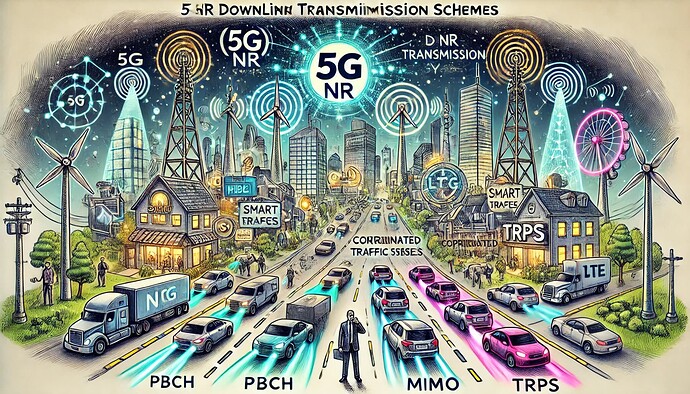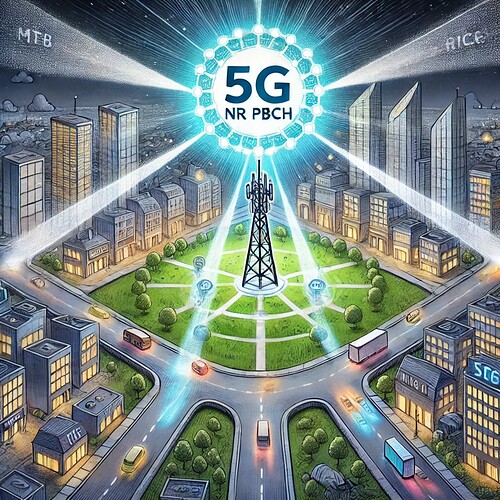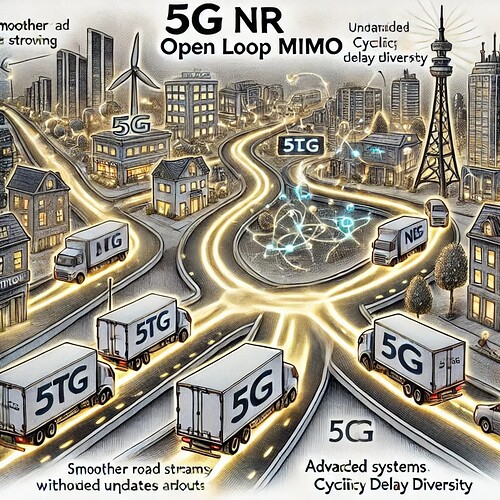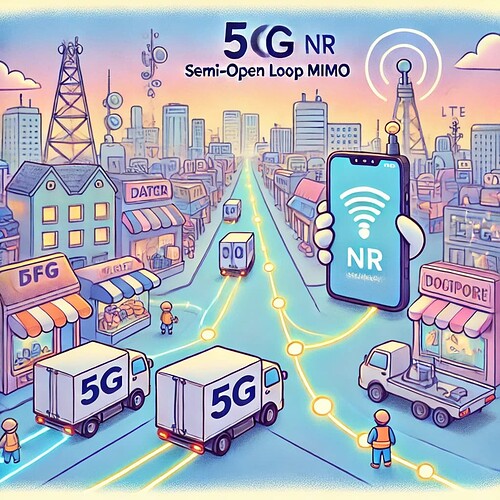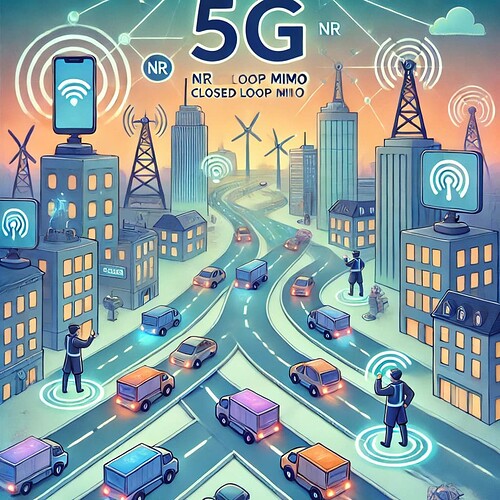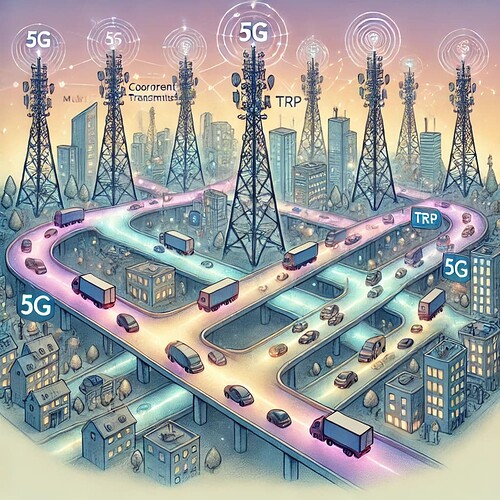This topic presents in a very simplified way all the main concepts that should be understood by those who know 5G NR.
5G NR Downlink Transmission Schemes
5G NR significantly improves downlink transmission schemes compared to LTE by enhancing efficiency, reliability, and adaptability. The PBCH simplifies device connections with a single antenna port and beamforming for better coverage. The PDCCH introduces CORESET for dynamic control signal placement, improving flexibility in high-density environments. The PDSCH supports up to 8 transmission layers and advanced features for faster, more reliable data delivery. MIMO techniques are more advanced in 5G, with Open Loop MIMO offering better reliability, Semi-Open Loop MIMO balancing limited feedback with precision, and Closed Loop MIMO using detailed feedback for optimized transmissions. Multi-User MIMO (MU-MIMO) increases efficiency by allowing multiple devices to share resources via spatial separation. Reciprocity-based transmission optimizes downlink performance using uplink measurements, reducing overhead. Lastly, Multiple Transmit and Receive Point (TRP) schemes improve performance at cell edges, leveraging coordinated transmission strategies. These advancements make 5G NR far superior to LTE, addressing modern connectivity demands more effectively. [In a Nutshell: 5G NR improves efficiency, reliability, and adaptability compared to LTE with smarter tools and advanced features.]
![]() In LTE’s city, everything was a bit slower and less organized - there were fixed traffic officers, smaller delivery trucks, and fewer tools to handle busy roads. In 5G’s city, it’s like they’ve built a super-smart traffic system! There’s a big welcome board with spotlights (PBCH) that quickly shows new visitors where to go. Traffic officers (PDCCH) can move around and use megaphones to guide cars better. Delivery trucks (PDSCH) are bigger and faster, with smart GPS tools to find the best routes, even in traffic jams. The highways now let multiple cars share the same lane (MU-MIMO), with advanced signals to keep everything smooth. Sensors on outgoing cars (reciprocity-based) help manage incoming traffic, and multiple traffic towers (TRPs) work together at the city’s edges to make sure no one gets lost. It’s like the ultimate upgrade - faster, smarter, and ready for more! [In a Nutshell: 5G’s city has a smarter traffic system, with dynamic tools for faster, smoother, and more reliable connections than LTE.]
In LTE’s city, everything was a bit slower and less organized - there were fixed traffic officers, smaller delivery trucks, and fewer tools to handle busy roads. In 5G’s city, it’s like they’ve built a super-smart traffic system! There’s a big welcome board with spotlights (PBCH) that quickly shows new visitors where to go. Traffic officers (PDCCH) can move around and use megaphones to guide cars better. Delivery trucks (PDSCH) are bigger and faster, with smart GPS tools to find the best routes, even in traffic jams. The highways now let multiple cars share the same lane (MU-MIMO), with advanced signals to keep everything smooth. Sensors on outgoing cars (reciprocity-based) help manage incoming traffic, and multiple traffic towers (TRPs) work together at the city’s edges to make sure no one gets lost. It’s like the ultimate upgrade - faster, smarter, and ready for more! [In a Nutshell: 5G’s city has a smarter traffic system, with dynamic tools for faster, smoother, and more reliable connections than LTE.]
Skip to: Roadmap to 5G NR
- PBCH
- PDCCH
- PDSCH
- Open Loop MIMO
- Semi-Open Loop MIMO
- Closed Loop MIMO
- Multi-User MIMO
- Reciprocity Based
- Multiple TRP
PBCH
The PBCH (Physical Broadcast Channel) in 5G NR is responsible for transmitting essential system information, such as the Master Information Block (MIB), which devices use to connect and understand the basic network setup. In LTE, PBCH transmissions used multiple antenna ports, requiring the device to figure out which configuration was being used. In 5G NR, the PBCH uses a single antenna port, simplifying device processing and reducing the time required for connection setup. Beamforming is integrated into PBCH transmissions, allowing signals to be directed towards specific areas, improving coverage and reliability in challenging environments such as dense urban locations or areas with weak signals. [In a Nutshell: The PBCH delivers critical network information more efficiently in 5G, using one antenna port and beamforming for better coverage than LTE.]
![]() Imagine entering a city and finding a central billboard that displays all the essential information you need - like maps, rules, and how to get around. In LTE’s city, there were multiple smaller billboards, and visitors had to figure out which one to look at, which took more time and effort. In 5G’s city, there is a single, highly visible digital billboard (PBCH) that updates dynamically and uses spotlight beams (beamforming) to ensure every visitor can see it clearly, even in crowded or hard-to-reach areas like busy downtowns or foggy outskirts. This new system makes it faster and easier for people (devices) to get connected and start navigating the city. [In a Nutshell: 5G’s PBCH is like a smart digital billboard that simplifies access to essential city information compared to LTE’s scattered signs.]
Imagine entering a city and finding a central billboard that displays all the essential information you need - like maps, rules, and how to get around. In LTE’s city, there were multiple smaller billboards, and visitors had to figure out which one to look at, which took more time and effort. In 5G’s city, there is a single, highly visible digital billboard (PBCH) that updates dynamically and uses spotlight beams (beamforming) to ensure every visitor can see it clearly, even in crowded or hard-to-reach areas like busy downtowns or foggy outskirts. This new system makes it faster and easier for people (devices) to get connected and start navigating the city. [In a Nutshell: 5G’s PBCH is like a smart digital billboard that simplifies access to essential city information compared to LTE’s scattered signs.]
- Search Forum
 5G NR PBCH
5G NR PBCH 
PDCCH
The PDCCH (Physical Downlink Control Channel) carries critical control information, such as scheduling and resource allocation details, guiding devices on how and when to receive or send data. In LTE, the PDCCH was static and less flexible, while in 5G NR, it is dynamically configured using CORESET (Control Resource Set). CORESET enables flexible placement of PDCCH within the frequency spectrum, allowing better adaptation to different network conditions. Beamforming further enhances the PDCCH in 5G NR, ensuring more reliable control signal delivery, especially in high-density environments or at high-frequency bands. [In a Nutshell: The PDCCH in 5G uses dynamic configurations and beamforming for better control signal delivery compared to LTE’s static approach.]
![]() In LTE’s city, traffic officers (PDCCH) were stationed at fixed intersections, directing vehicles on where to go and when to move. While this worked, it wasn’t adaptable during rush hour or unexpected traffic jams. In 5G’s city, the officers are much smarter and can move around to where they’re needed most (CORESET). They also use megaphones (beamforming) to ensure every driver hears their instructions clearly, even in noisy, crowded areas or far-away neighborhoods. This new system ensures smoother traffic flow, no matter how busy or complex the city gets. [In a Nutshell: 5G’s PDCCH is like smarter, mobile traffic officers with megaphones, improving adaptability and communication compared to LTE.]
In LTE’s city, traffic officers (PDCCH) were stationed at fixed intersections, directing vehicles on where to go and when to move. While this worked, it wasn’t adaptable during rush hour or unexpected traffic jams. In 5G’s city, the officers are much smarter and can move around to where they’re needed most (CORESET). They also use megaphones (beamforming) to ensure every driver hears their instructions clearly, even in noisy, crowded areas or far-away neighborhoods. This new system ensures smoother traffic flow, no matter how busy or complex the city gets. [In a Nutshell: 5G’s PDCCH is like smarter, mobile traffic officers with megaphones, improving adaptability and communication compared to LTE.]
- Search Forum
 5G NR PDCCH
5G NR PDCCH 
PDSCH
The PDSCH (Physical Downlink Shared Channel) is the main channel for delivering user data, such as videos, files, or messages. While the PDSCH existed in LTE, 5G NR enhances it with support for up to 8 transmission layers, enabling higher data throughput. Advanced configurations, including flexible DMRS (Demodulation Reference Signal) placement and Resource Block Bundling, ensure accurate and efficient data delivery, even in challenging conditions like poor signal quality or high user density. Additionally, 5G’s integration of beamforming and dynamic resource allocation makes PDSCH transmissions faster, more reliable, and more adaptable than in LTE. [In a Nutshell: 5G’s PDSCH delivers data faster and more efficiently, with advanced features like multiple layers and beamforming compared to LTE.]
![]() In LTE’s city, delivery trucks (PDSCH) carried packages like videos, messages, or files to homes, but they were smaller and often struggled during rush hours or in crowded neighborhoods. In 5G’s city, the trucks are much larger, faster, and better equipped, with up to 8 trailers (transmission layers) to carry more packages at once. They also use advanced navigation tools (DMRS placement and Resource Block Bundling) to find the best routes, even in areas with heavy traffic or poor roads. Spotlights from towers (beamforming) guide the trucks efficiently, ensuring deliveries are quicker and more reliable than ever before. [In a Nutshell: 5G’s PDSCH is like bigger, faster trucks with smarter navigation, making deliveries more reliable and efficient than LTE.]
In LTE’s city, delivery trucks (PDSCH) carried packages like videos, messages, or files to homes, but they were smaller and often struggled during rush hours or in crowded neighborhoods. In 5G’s city, the trucks are much larger, faster, and better equipped, with up to 8 trailers (transmission layers) to carry more packages at once. They also use advanced navigation tools (DMRS placement and Resource Block Bundling) to find the best routes, even in areas with heavy traffic or poor roads. Spotlights from towers (beamforming) guide the trucks efficiently, ensuring deliveries are quicker and more reliable than ever before. [In a Nutshell: 5G’s PDSCH is like bigger, faster trucks with smarter navigation, making deliveries more reliable and efficient than LTE.]
- Search Forum
 5G NR PDSCH
5G NR PDSCH 
Open Loop MIMO
Open Loop MIMO in 5G is a way for the network to send multiple streams of data to a device without requiring detailed feedback from it. Instead of the device reporting precise details, it provides simpler information about signal quality and data capacity. This approach makes the process more straightforward and works well in situations where fast feedback isn’t practical or needed, like in rapidly changing conditions. Techniques like Precoder Cycling and Cyclic Delay Diversity (CDD) are used to improve signal reliability and performance. While LTE also used Open Loop MIMO, 5G has made it more flexible and efficient, adapting it better to modern scenarios and challenging environments. [In a Nutshell: Open Loop MIMO in 5G sends data streams efficiently without detailed feedback, improving reliability compared to LTE.]
![]() In LTE’s city, some delivery trucks (data streams) were sent along multiple lanes without knowing exactly how busy the roads were. This worked but wasn’t always efficient. In 5G’s city, these trucks still use the same system (Open Loop MIMO), but now the city has upgraded the roads with smoother surfaces and better traffic management tools (like Precoder Cycling and CDD). These improvements make it easier for the trucks to reach their destination, even during unexpected traffic changes, ensuring reliable deliveries in busy or unpredictable areas. [In a Nutshell: 5G’s Open Loop MIMO is like smarter, smoother roads for delivery trucks, ensuring better reliability in changing conditions compared to LTE.]
In LTE’s city, some delivery trucks (data streams) were sent along multiple lanes without knowing exactly how busy the roads were. This worked but wasn’t always efficient. In 5G’s city, these trucks still use the same system (Open Loop MIMO), but now the city has upgraded the roads with smoother surfaces and better traffic management tools (like Precoder Cycling and CDD). These improvements make it easier for the trucks to reach their destination, even during unexpected traffic changes, ensuring reliable deliveries in busy or unpredictable areas. [In a Nutshell: 5G’s Open Loop MIMO is like smarter, smoother roads for delivery trucks, ensuring better reliability in changing conditions compared to LTE.]
- Search Forum
 5G NR Open Loop MIMO
5G NR Open Loop MIMO 
Semi-Open Loop MIMO
Semi-Open Loop MIMO is a new feature in 5G NR that was not available in LTE. It enables the network to refine data transmissions using limited feedback from devices, such as signal quality and capacity. Unlike LTE, which relied on simpler methods or required detailed feedback, 5G’s Semi-Open Loop MIMO strikes a balance between simplicity and precision. It is particularly effective in rapidly changing environments, such as crowded areas or when users are on the move, by focusing signals more efficiently with multiple antennas. This enhancement makes data delivery in 5G more reliable and adaptable, significantly surpassing LTE’s capabilities. [In a Nutshell: Semi-Open Loop MIMO in 5G balances limited feedback with precision, offering better adaptability and reliability than LTE.]
![]() In 5G’s enhanced city, delivery trucks (data streams) now have a GPS system (limited feedback from devices) that gives basic updates about traffic ahead, like road quality or congestion, but without needing constant directions. This system (Semi-Open Loop MIMO) helps the city refine routes for the trucks, ensuring they avoid jams and deliver packages smoothly. LTE’s city didn’t have this system and either relied on no feedback or detailed reports, making it less flexible. With Semi-Open Loop MIMO, 5G’s city can handle dynamic environments like busy markets or highways more efficiently, balancing speed and precision. [In a Nutshell: Semi-Open Loop MIMO in 5G is like trucks guided by GPS for smooth delivery in ever-changing traffic, unlike LTE’s rigid methods.]
In 5G’s enhanced city, delivery trucks (data streams) now have a GPS system (limited feedback from devices) that gives basic updates about traffic ahead, like road quality or congestion, but without needing constant directions. This system (Semi-Open Loop MIMO) helps the city refine routes for the trucks, ensuring they avoid jams and deliver packages smoothly. LTE’s city didn’t have this system and either relied on no feedback or detailed reports, making it less flexible. With Semi-Open Loop MIMO, 5G’s city can handle dynamic environments like busy markets or highways more efficiently, balancing speed and precision. [In a Nutshell: Semi-Open Loop MIMO in 5G is like trucks guided by GPS for smooth delivery in ever-changing traffic, unlike LTE’s rigid methods.]
- Search Forum
 5G NR Semi-Open Loop MIMO
5G NR Semi-Open Loop MIMO 
Closed Loop MIMO
Closed Loop MIMO in 5G is a significant improvement over LTE. While LTE also used feedback from devices to optimize transmissions, it had limited configurations and capabilities. In 5G, Closed Loop MIMO uses much more detailed feedback from devices, allowing the network to fine-tune transmissions with greater precision. This includes advanced features like beamforming and support for higher-order MIMO, which enable the use of many antennas to send data more efficiently, even to multiple devices at once. These enhancements make 5G’s Closed Loop MIMO far more effective at delivering fast, reliable data in complex and high-demand environments compared to LTE’s more basic approach. [In a Nutshell: Closed Loop MIMO in 5G uses detailed feedback to optimize data delivery, making it more precise and reliable than LTE.]
![]() In LTE’s city, traffic officers (Closed Loop MIMO) received basic updates from drivers about traffic conditions and adjusted signals accordingly. However, their tools were limited, so adjustments weren’t always perfect. In 5G’s city, these officers now have access to detailed, real-time updates from drivers (devices) about road conditions, vehicle positions, and speeds. With this information, they can direct traffic with incredible precision, using advanced tools like custom traffic patterns (beamforming) and multi-lane systems (higher-order MIMO) to ensure smooth and efficient flow. This makes 5G’s Closed Loop MIMO far more effective at managing high-demand traffic compared to LTE’s simpler system. [In a Nutshell: 5G’s Closed Loop MIMO is like smarter traffic officers using detailed updates to optimize traffic flow, unlike LTE’s simpler approach.]
In LTE’s city, traffic officers (Closed Loop MIMO) received basic updates from drivers about traffic conditions and adjusted signals accordingly. However, their tools were limited, so adjustments weren’t always perfect. In 5G’s city, these officers now have access to detailed, real-time updates from drivers (devices) about road conditions, vehicle positions, and speeds. With this information, they can direct traffic with incredible precision, using advanced tools like custom traffic patterns (beamforming) and multi-lane systems (higher-order MIMO) to ensure smooth and efficient flow. This makes 5G’s Closed Loop MIMO far more effective at managing high-demand traffic compared to LTE’s simpler system. [In a Nutshell: 5G’s Closed Loop MIMO is like smarter traffic officers using detailed updates to optimize traffic flow, unlike LTE’s simpler approach.]
- Search Forum
 5G NR Closed Loop MIMO
5G NR Closed Loop MIMO 
MU-MIMO (Multi-User MIMO)
Multi-User MIMO (MU-MIMO) in 5G NR allows multiple devices to share the same resource blocks by separating their transmissions in the spatial domain. This improves spectral efficiency and system capacity, enabling multiple users to be served simultaneously. Unlike Single-User MIMO, where each device has dedicated resource blocks, MU-MIMO requires careful selection of users with sufficient spatial separation to minimize interference. Massive MIMO and advanced beamforming techniques are used to enhance spatial separation and support more users. Although MU-MIMO existed in LTE, 5G expands its capabilities with advanced antennas and digital beamforming, increasing efficiency and adaptability in both uplink and downlink scenarios. This method is critical for optimizing network performance, especially in environments with high user density. [In a Nutshell: MU-MIMO in 5G allows multiple devices to share resources efficiently, with advanced tools making it more capable than LTE.]
![]() In LTE’s city, each car (device) had its own lane on the highway (resource block), which limited how many cars could travel at once. In 5G’s city, the roads are much smarter. Multiple cars can now share the same lane, thanks to advanced traffic systems (MU-MIMO) that use spatial separation to ensure they don’t collide. Smart traffic signals (beamforming) and highly coordinated road designs (Massive MIMO) guide the cars efficiently. This allows many more vehicles to move at the same time, making the 5G city much more capable of handling crowded highways compared to LTE’s limited setup. [In a Nutshell: 5G’s MU-MIMO is like smarter highways allowing multiple cars in one lane, unlike LTE’s one-car-per-lane system.]
In LTE’s city, each car (device) had its own lane on the highway (resource block), which limited how many cars could travel at once. In 5G’s city, the roads are much smarter. Multiple cars can now share the same lane, thanks to advanced traffic systems (MU-MIMO) that use spatial separation to ensure they don’t collide. Smart traffic signals (beamforming) and highly coordinated road designs (Massive MIMO) guide the cars efficiently. This allows many more vehicles to move at the same time, making the 5G city much more capable of handling crowded highways compared to LTE’s limited setup. [In a Nutshell: 5G’s MU-MIMO is like smarter highways allowing multiple cars in one lane, unlike LTE’s one-car-per-lane system.]
- Search Forum
 5G NR Multi-User MIMO
5G NR Multi-User MIMO 
Reciprocity Based
Reciprocity-based transmission in 5G NR leverages measurements of uplink signals, such as those derived from Sounding Reference Signal (SRS) transmissions, to optimize downlink transmissions. This method allows the base station to use detailed uplink propagation data to calculate downlink precoding, achieving higher frequency resolution without relying solely on user equipment (UE) feedback for the downlink channel. While the UE still provides Channel Quality Indicator (CQI) to report interference and noise conditions for the downlink, reciprocity-based schemes reduce overhead and enhance performance in dynamic scenarios. This feature represents a key advancement in 5G NR, offering enhanced adaptability and efficiency in resource allocation compared to LTE, which lacked such advanced capabilities. [In a Nutshell: Reciprocity-based transmission in 5G uses uplink data to improve downlink performance, enhancing efficiency and adaptability over LTE.]
![]() In LTE’s city, traffic lights adjusted based on what traffic officers observed from passing cars (downlink feedback), but this took extra time and wasn’t always efficient. In 5G’s city, the traffic system is smarter. It uses sensors on outgoing cars (uplink signals) to predict and manage incoming traffic (downlink transmissions) without waiting for detailed reports from drivers. This advanced system (reciprocity-based transmission) ensures smoother traffic flow and better use of road space, making the 5G city much more efficient and adaptable compared to LTE, which didn’t have this capability. [In a Nutshell: Reciprocity-based transmission in 5G is like smart traffic lights using outgoing cars to predict and manage incoming traffic, unlike LTE’s slower system.]
In LTE’s city, traffic lights adjusted based on what traffic officers observed from passing cars (downlink feedback), but this took extra time and wasn’t always efficient. In 5G’s city, the traffic system is smarter. It uses sensors on outgoing cars (uplink signals) to predict and manage incoming traffic (downlink transmissions) without waiting for detailed reports from drivers. This advanced system (reciprocity-based transmission) ensures smoother traffic flow and better use of road space, making the 5G city much more efficient and adaptable compared to LTE, which didn’t have this capability. [In a Nutshell: Reciprocity-based transmission in 5G is like smart traffic lights using outgoing cars to predict and manage incoming traffic, unlike LTE’s slower system.]
- Search Forum
 5G NR Reciprocity Based
5G NR Reciprocity Based 
Multiple TRP
In 5G NR, Multiple Transmit and Receive Point (TRP) transmission schemes are introduced to improve performance, particularly at the cell edges where users are more vulnerable to interference. These schemes aim to leverage multiple base stations or transmit points to enhance signal quality and reliability. Solutions include Coherent Joint Transmission, where multiple TRPs transmit the same data in a coordinated manner, requiring precise synchronization and transport networks, and Non-Coherent Joint Transmission, where different TRPs transmit separate data layers, improving throughput by exploiting spatial diversity. These methods offer significant enhancements over LTE, which lacked such coordinated multi-point capabilities, thereby allowing 5G to support advanced applications and challenging scenarios effectively. [In a Nutshell: Multiple TRPs in 5G work together to improve reliability and coverage, especially at cell edges, unlike LTE’s single-tower system.]
![]() In LTE’s city, a single traffic tower managed each neighborhood, which worked well in central areas but left the city edges with weak signals and frequent delays. In 5G’s city, multiple coordinated towers (TRPs) now work together to manage traffic, especially in areas prone to jams or weak coverage. Some towers send the same instructions together (Coherent Joint Transmission), ensuring everyone gets the message clearly, while others send separate instructions (Non-Coherent Joint Transmission) to divide traffic and speed up flow. This collaboration makes 5G’s city much more reliable and efficient, particularly in busy or hard-to-reach areas, compared to LTE’s single-tower system. [In a Nutshell: 5G’s TRPs are like coordinated towers working together to ensure smooth traffic, unlike LTE’s single tower per area.]
In LTE’s city, a single traffic tower managed each neighborhood, which worked well in central areas but left the city edges with weak signals and frequent delays. In 5G’s city, multiple coordinated towers (TRPs) now work together to manage traffic, especially in areas prone to jams or weak coverage. Some towers send the same instructions together (Coherent Joint Transmission), ensuring everyone gets the message clearly, while others send separate instructions (Non-Coherent Joint Transmission) to divide traffic and speed up flow. This collaboration makes 5G’s city much more reliable and efficient, particularly in busy or hard-to-reach areas, compared to LTE’s single-tower system. [In a Nutshell: 5G’s TRPs are like coordinated towers working together to ensure smooth traffic, unlike LTE’s single tower per area.]
- Search Forum
 5G NR Multiple TRP
5G NR Multiple TRP 
That’s it. ![]()
-
Continue reading: Roadmap to 5G NR - Flow of Downlink Data
-
Or back to: Roadmap to 5G NR
